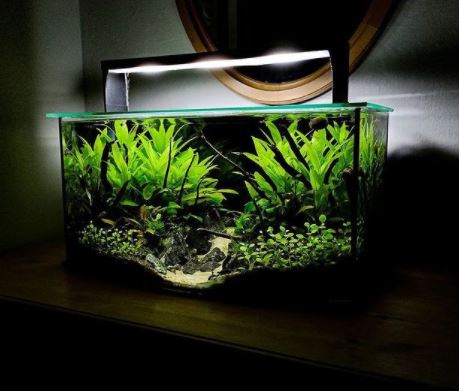Can you keep a tortoise in a fish tank?
This is the question we explore in this article.
The answer is not as simple as it may seem, and there are many considerations to take into account when deciding whether or not to house your pet tortoise in such an environment.
We provide some guidelines for keeping your pet healthy and happy while living in a home that doesn’t meet what’s considered standard requirements for their species.
Related Posts:
- Best Tortoise Enclosure
- How to Decorate a Tortoise Enclosure?
- Best Heat Lamp for Tortoise
- How to Maintain Humidity in a Tortoise Tank?
Can You Keep a Tortoise in a Fish Tank?
So, can you keep a tortoise in a fish tank? No, tortoises should not live in an aquarium.
Tortoises can’t breathe well in an aquarium and they don’t have enough space to walk around. It is stressful for tortoises to live in tanks because they can see through the glass and feel trapped.
Can Tortoises Swim in Water?
The answer is yes. At least the species of large tortoise can swim if necessary.
Whether other species do, too, remains unknown. One thing’s clear, though. You definitely don’t want to get between this animal and the nearest river or lake!
They are also fast swimmers when in water, with reports of these animals reaching speeds of 10 km/h.
The African spurred tortoise is a short-necked or angulated tortoise that inhabits grasslands and savannahs of eastern Africa.
One of the largest species in the world, they can reach more than 80 cm in length and weigh up to 20 kg.
An interesting fact about this species is its ability to cross bodies of water such as rivers and lakes by remaining submerged for longer periods than other turtles.
It’s only on the tips of their shell that you see these creatures coming out above water to take a breath before going back under.
It has been suggested that when the tortoises submerge, small pockets of air get trapped between plates on their shell and help them stay submerged.
While it is not clear how much time they can remain underwater, the African spurred tortoise has been recorded to have remained submerged in a muddy pool for up to 30 minutes without coming up for air.
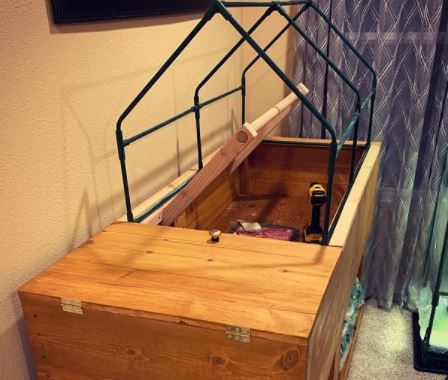
Can You Keep a Tortoise in a Glass Tank?
No, keeping a tortoise in such an enclosure will not provide it with proper support and can lead to serious injuries.
There are many reasons for this, but the most important one is that tortoises require very high humidity to be able to go through their natural habitat cycle properly.
Glass tanks have very little surface area on which water droplets can form, so they cannot produce enough of it by themselves.
If you want your tortoise to live healthily, you need something on top of the glass where condensation can build up easily (e.g., some kind of mesh or fiberglass lid fastened on top of the tank with clips or screws).
Keep in mind that this lid must be very lightweight because tortoises are heavy animals when compared to their enclosure.
You don’t want it crashing down on your pet’s fragile shell due to a bow in the mesh or a loose screw, causing serious injury or even death.
Please note that if you already have a glass tank and want to set up a vivarium where humidity can build up easily, there is no need to go out and buy a whole new cage for your pet!
It may seem counterintuitive, but many keepers of smaller reptiles successfully maintain high humidity levels by simply filling up large Tupperware containers with water and placing them inside their pets’ enclosures next to the heat lamp.
Some people have reported good results by placing a smaller container inside the larger one, filling up the gap between them with sphagnum moss, and letting it sit under the lamp for extended periods of time.
Some even manage to create quite an elaborate “tortoise spa” by putting in stones or branches in there for their pet to crawl onto.
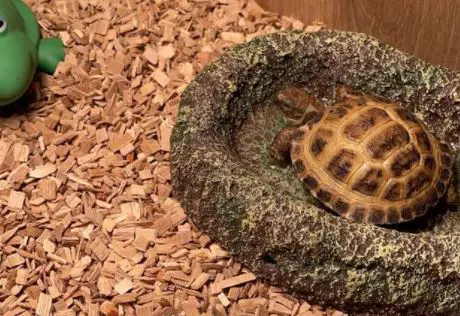
How Big Should a Tortoise Enclosure Be?
We have been asked this question many times. The size of the terrarium or pen is quite important for your pet’s health and well-being. In general, it is recommended that they be allowed to roam around in an area away from their shelter.
Tortoises need exercise to remain healthy and happy animals.
They also need a place where they can hide when they feel insecure or stressed.
A four-foot by eight-foot enclosure will allow most Russian tortoises lots of room to run and play when you are not watching them!
There is no specific formula to follow when deciding on the proper enclosure for your pet tortoise.
The size of the pen must be large enough for them to get away from their food, water, and shelter in case they don’t like something that is going on with their living quarters.
They should also be able to walk around without touching any side of the pen or climbing over rocks that are too steep. Of course, bigger is always better when it comes to providing enough room for them to move around comfortably in.
You can keep young tortoises indoors in a smaller area, but they will need more space as they grow older.
Old-timers recommend at least 12 square feet for one animal, 18 square feet if you have two animals together, and 20 square feet for each additional tortoise beyond that.
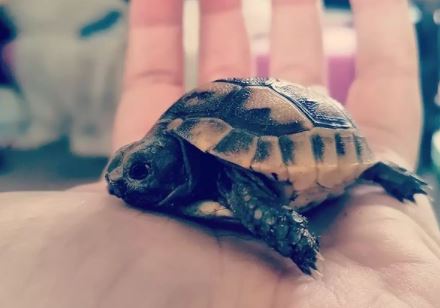
Do not keep your pet in an enclosure that is too small. Whether kept indoors or out, it should be big enough to provide varied and interesting terrain for them to explore and wander around in.
They love climbing on rocks, logs, and plants and they need to be able to go all the way around these items when exploring their surroundings.
It is expensive and very frustrating (for both you and your pet) if you have to remodel your animal’s entire living quarters simply because it was too small from the start!
You also need to consider the humidity levels in the enclosure when choosing between indoor or outdoor housing. Many tortoises can handle brief periods of exposure to colder outdoor temperatures, but some fare better indoors.
If you keep your pet indoors, then the enclosure should be at least four feet by eight feet with a secure roof to prevent escape.
You also need to be able to provide it with heat and UVB lighting if they are going to be outside for most of the year. The more time spent outdoors, the larger the pen must be so they can get away from their shelter or basking area when needed.
Remember that tortoises are not domesticated animals who have been bred in captivity over thousands of generations to live in your living room!
They are still wild animals with both physical and emotional needs that must be taken into consideration before deciding on housing them either indoors or out.
Take these basic guidelines into consideration when building or purchasing an enclosure for your pet.
How to Make a Tortoise Enclosure Using Recycled Pallets?
Once upon a time, there lived four tortoises: Matuka, Shelly, Puka, and Pop.
Although they were all different in their own special way, the one thing that they all had in common was that after a certain age, they could not be housed in a regular glass tank anymore and needed to move into an outdoor tortoise enclosure.
The problem was, however, that we live in an apartment and therefore do not have access to any land where we can build our own DIY tortoise enclosure.
That was until we saw this amazing pallet tortoise habitat! We know it seems ridiculous to have a lot of people take care of four slow-paced reptiles, but nothing is impossible.
A pallet tortoise enclosure is made from recycled pallets and it’s so easy to build. You could do it yourself over a weekend.
The design of this tortoise enclosure allows for optimal drainage as well as an easily removable top that makes caring for your pets simple and accessible. It also looks just plain cool! Read on to see how we made our own DIY pallet tortoise habitat.
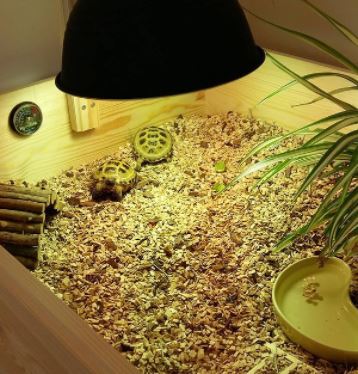
How to Make a DIY Pallet Tortoise Enclosure?
You will need (for one side):
- Palettes (we used 5)
- Strips of plywood (we used 3 packs, each containing twelve strips, but the length may vary depending on the size of your pallets)
- Screws
- Duct tape (optional)
Here are the steps to follow:
- Remove the boards from the palettes by loosely unscrewing them. Not all boards will come out, but that is no problem. You can still use the part of the palette that is left intact. You can also keep them in if you want to (see step 3).
- Cut the plywood strips to size, according to your preference and needs. We made ours five inches wide for each strip with a length equal to the width of three boards on one side of our pallet. If needed, you could also screw some parts together. Don’t forget to sand off any exposed nails at this point!
- Screw or tape your strips onto the intact sides of your pallet.
- Place the recessed side of the pallet against a wall to create an elevated tortoise enclosure. It can be any length, but remember that you will need at least two additional pallets in height for each consecutive level if you want it to also be suitable as a multi-level tortoise habitat. Since we only have one TortoisePal, this is not possible with our current setup even though it already measures close to three feet in height. But hey, maybe next year!
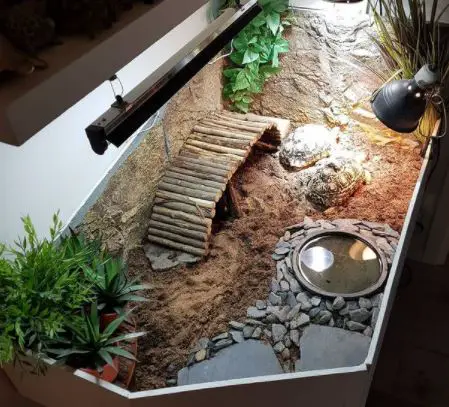
Conclusion
Can you keep a tortoise in a fish tank?
As long as the tortoise is getting enough light, has plenty of water to drink and bathe in, and seems happy with his living conditions, then you can keep your pet turtle in a fish tank.
Make sure that he gets time outside to bask under direct sunlight though, or else, it may lead to health issues like a metabolic bone disease.
These are all considerations for keeping any animal healthy but especially for turtles who require specific care if they’re going to live inside an enclosed space like this one.
I hope we answered your question, “Can you keep a tortoise in a fish tank?”
Further Reading:
- Top 9 Best Substrate for Russian Tortoise
- Best Substrate for Sulcata Tortoise: Guideline for the New Keepers
- 7 Best UVB Bulbs for Sulcata Tortoise
- 7 Best Food for Tortoise
- Top 6 Best Substrate for Leopard Tortoise
- Top 7 Best Heat Lamps for Tortoise

